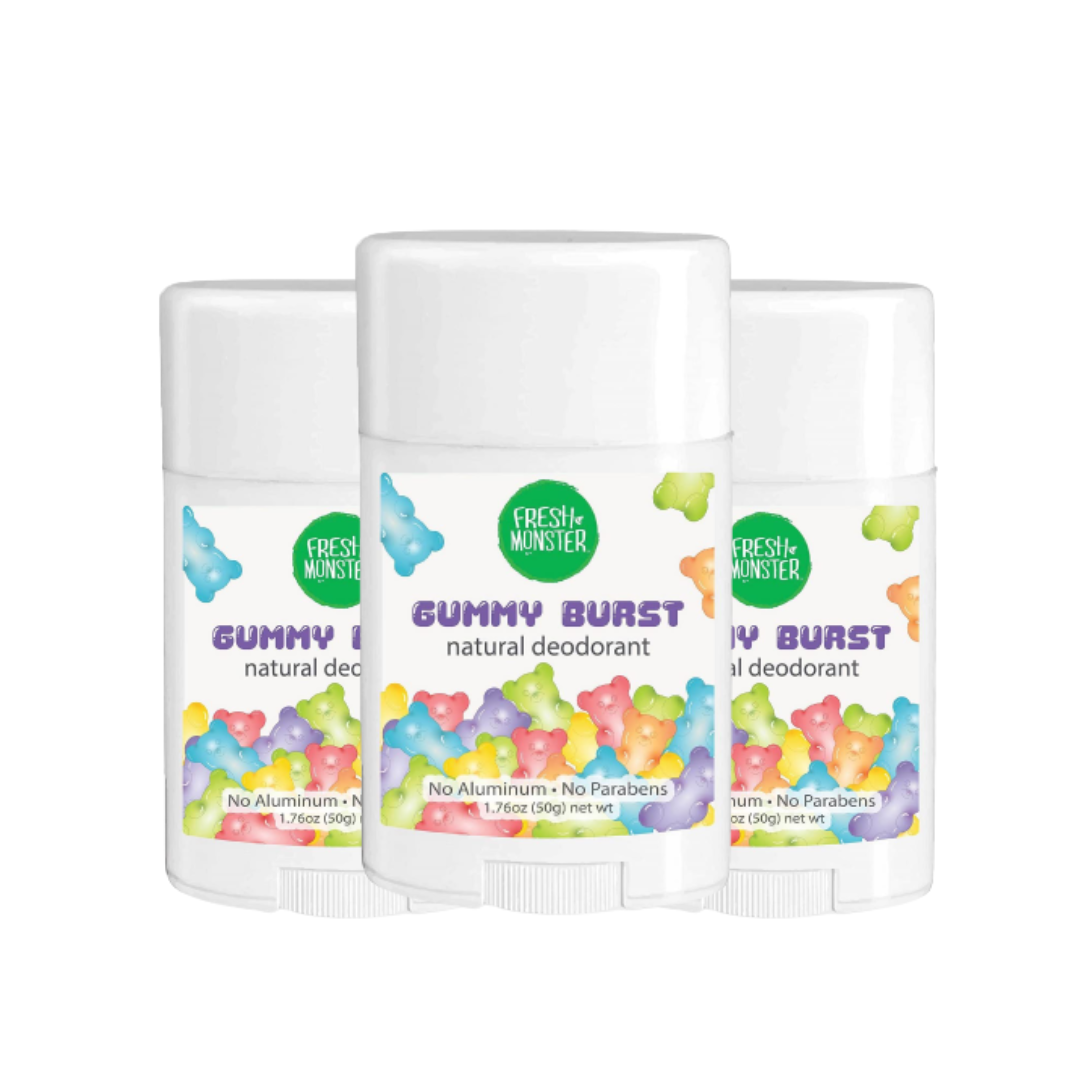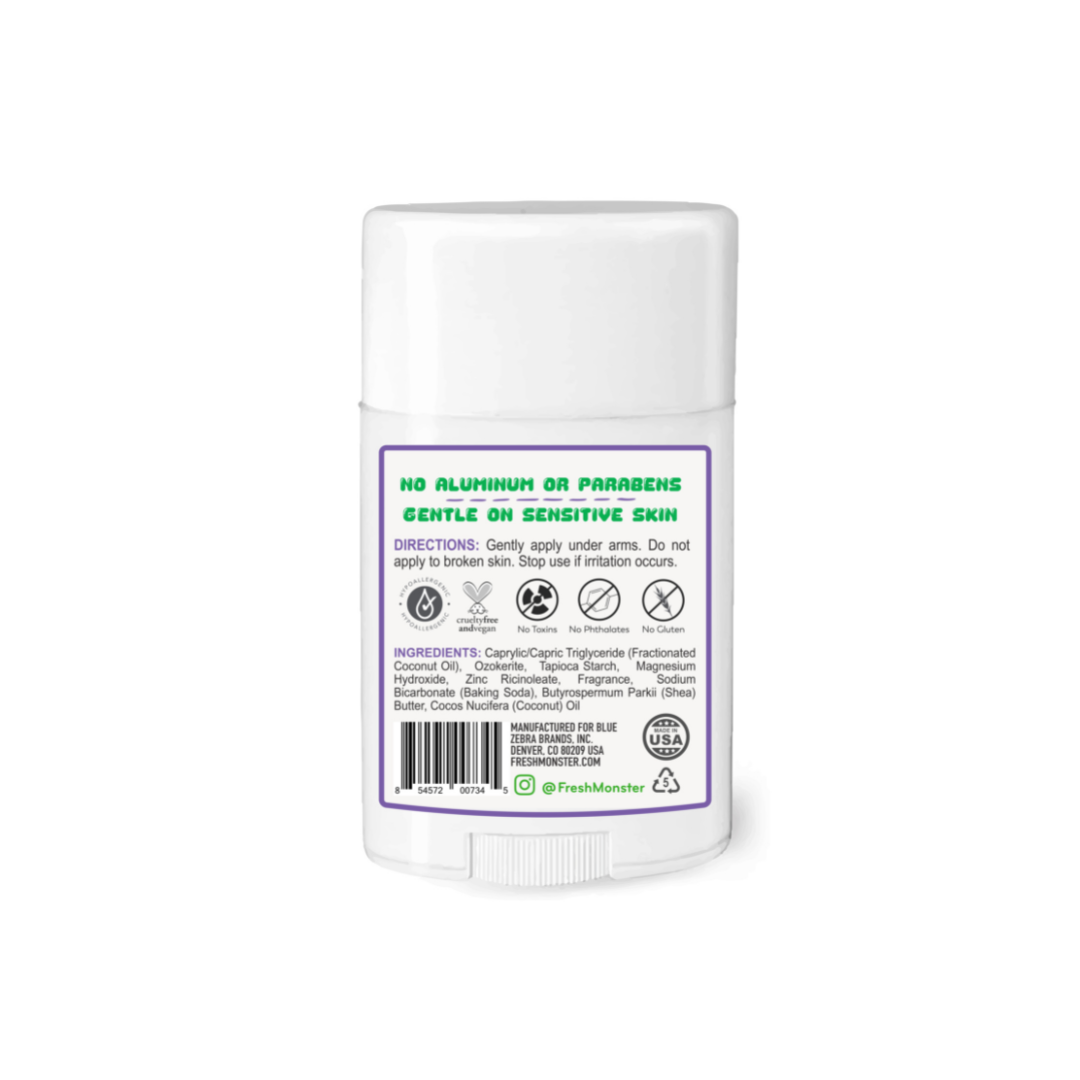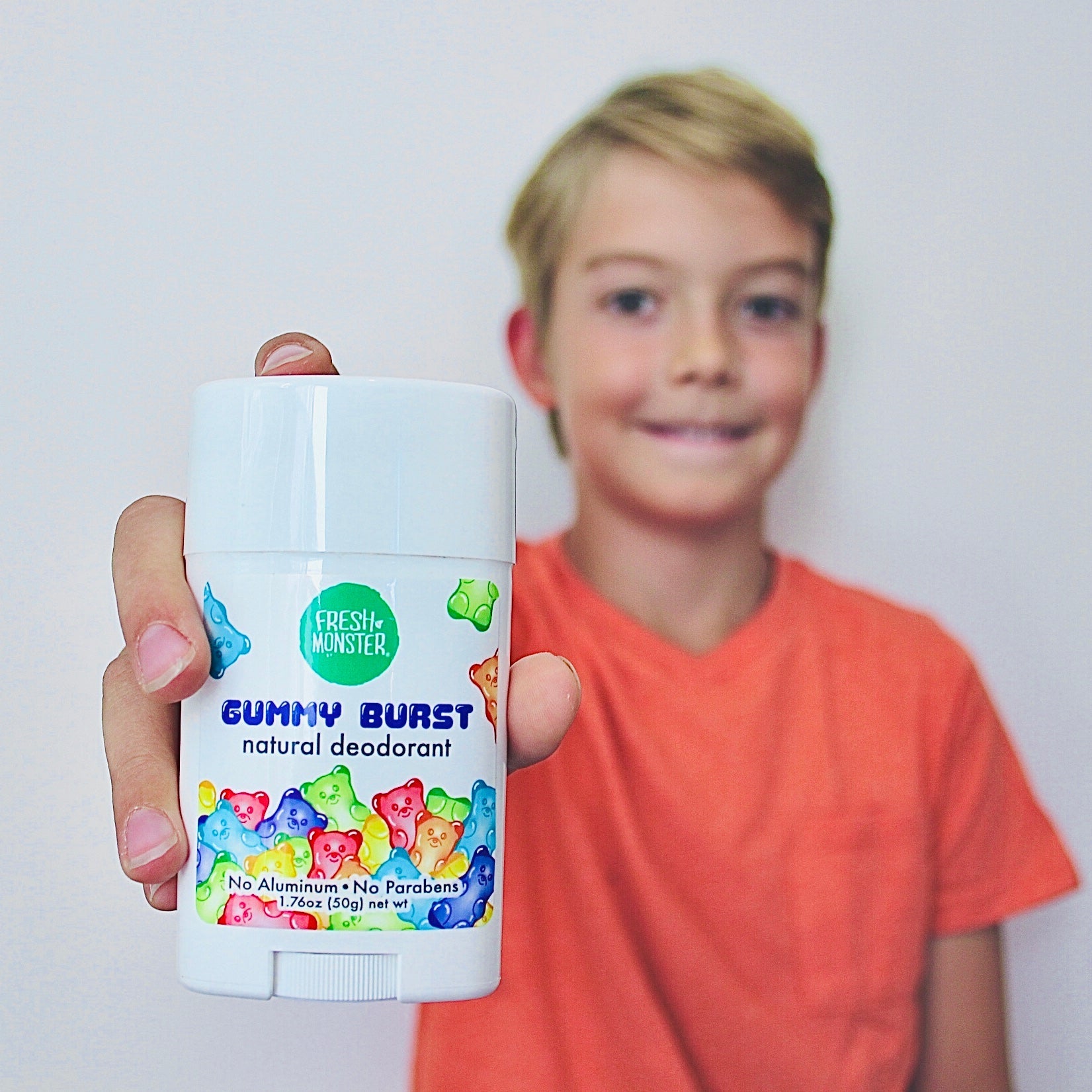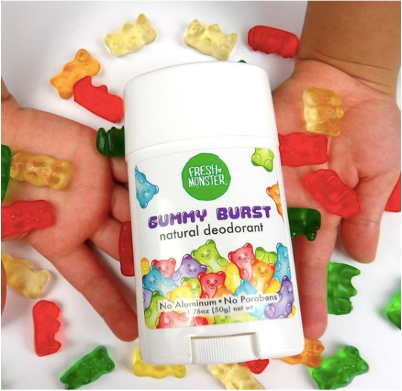




Fresh Monster Kids Deodorant - 24-Hour Odor Protection, Hypoallergenic, Gummy Burst - 1.76oz, 3 Pack


Fragrance
High RiskFragrance refers to a mixture of aromatic compounds used in products to provide scent. It is commonly listed as 'fragrance' or 'parfum' on product labels and can serve various functions, including enhancing user experience and masking undesirable odors.
Sustai Insights
Fragrance offers functional benefits by improving product appeal; however, it poses significant health risks, notably a high likelihood of causing allergies and allergic contact dermatitis. Environmental risks include potential pollution and endocrine disruption, though its overall carcinogenicity is low. Regulatory bodies have noted concerns regarding its use, leading to a high-risk classification. Safe usage practices should be observed, and alternatives such as natural essential oils are recommended for those sensitive to synthetic fragrances.
Butyrospermum Parkii (Shea) Butter
Low RiskButyrospermum parkii (shea) butter is a vegetable fat derived from the nuts of the shea tree. It is commonly used in cosmetic formulations for its emollient properties, providing moisture and improving skin texture. Additionally, shea butter is known for its ability to enhance the stability of products and deliver a creamy texture.
Sustai Insights
Shea butter offers functional benefits as an effective moisturizer, enhancing skin barrier function and texture. It is sustainably sourced and biodegradable, contributing to eco-friendliness. Health-wise, it is associated with low risks for carcinogenicity, allergies, and reproductive toxicity. Environmental impacts are minimal, with no significant pollutant potential identified. Regulatory assessments indicate no current restrictions. Overall, the ingredient presents a low risk, making it a favorable choice in cosmetic formulations.
Sodium Bicarbonate
Low RiskSodium bicarbonate, commonly known as baking soda, is an inorganic compound with the formula NaHCO₃. It functions primarily as a leavening agent in baking, helping to produce carbon dioxide gas when it reacts with acids, thereby causing dough to rise. It also serves as a mild alkaline agent in various personal care products.
Sustai Insights
Sodium bicarbonate is valued for its effectiveness as a leavening agent and its role in neutralizing acidity, contributing to product stability. It is considered environmentally friendly and biodegradable. Health risks are minimal, with low concerns regarding carcinogenicity, allergies, and reproductive toxicity. It is not classified as a pollutant and poses no significant environmental hazards. Regulatory assessments indicate it is safe for use in food and cosmetic products. Overall, sodium bicarbonate carries a low risk, making it a practical choice in many applications.
Tapioca Starch
Low RiskTapioca starch is a carbohydrate extracted from the cassava root, primarily used as a thickening agent in food products and as a binding agent in various formulations. It is known for its ability to provide a smooth texture and enhance the consistency of products.
Sustai Insights
Tapioca starch offers functional benefits such as serving as an effective thickener and stabilizer in food and cosmetic formulations. It is derived from a renewable source and is biodegradable, contributing to sustainability. Health risks are minimal, with low concerns regarding carcinogenicity, allergenic potential, and reproductive toxicity. Environmental risks are also low, with no significant pollutants or bioaccumulation identified. Regulatory bodies, including the FDA, have approved its use without significant restrictions. Overall, tapioca starch presents a low risk profile, making it a safe ingredient in various applications.
Caprylic Triglyceride
Low RiskCaprylic triglyceride is an ester derived from coconut oil and glycerin, commonly used in cosmetic formulations as an emollient, stabilizer, and skin-conditioning agent. It helps to improve the texture and spreadability of products while providing a lightweight, non-greasy feel.
Sustai Insights
Caprylic triglyceride offers functional benefits such as enhanced skin moisturization and improved formulation stability. It is generally regarded as safe, with low concerns regarding carcinogenicity, allergenic potential, and reproductive toxicity. Environmental impact is minimal, with no significant pollutant or bioaccumulative properties identified. Regulatory bodies have not issued warnings or restrictions. Overall, the risk level is low, making it a suitable ingredient in cosmetic products. Safe usage practices include adhering to recommended concentrations, and while there are alternatives, caprylic triglyceride remains a reliable choice.
Magnesium Hydroxide
Low RiskMagnesium hydroxide is an inorganic base commonly used in various applications, including as an antacid and laxative. It serves to neutralize stomach acid and relieve constipation. It is also utilized in wastewater treatment and as a flame retardant in plastics.
Sustai Insights
Magnesium hydroxide provides effective relief from indigestion and constipation, contributing to digestive health. It is recognized for its low environmental impact and is generally regarded as safe with minimal health risks, including low concerns for carcinogenicity, allergies, and reproductive toxicity. Regulatory bodies have few restrictions on its use, classifying it as low risk overall. However, precautions should be taken to avoid excessive consumption, and alternatives like calcium carbonate may be considered for similar functions. Overall, magnesium hydroxide is assessed as low risk.
Cocos Nucifera (Coconut) Oil
Low RiskCocos Nucifera (Coconut) Oil is derived from the kernels of the coconut palm. It is primarily used in cosmetic formulations for its emollient and moisturizing properties, making it suitable for skin and hair care products.
Sustai Insights
Coconut oil serves as an effective moisturizer and emollient, promoting skin hydration and softness. It is sustainably sourced and biodegradable. Health risks are minimal, with low concerns regarding carcinogenicity, allergens, and reproductive toxicity. Environmental impact is also low, as it does not contribute significantly to pollution or bioaccumulation. Regulatory bodies have not issued restrictions on its use. Overall, coconut oil presents a low risk for health and environmental concerns, making it a safe ingredient in cosmetic products.
Zinc Ricinoleate
Low RiskZinc ricinoleate is a zinc salt of ricinoleic acid, primarily used in cosmetics for its properties as an odor-neutralizing agent. It functions by complexing with odor molecules, thereby reducing their volatility and effectiveness. This ingredient is often found in personal care products such as deodorants and body sprays.
Sustai Insights
Zinc ricinoleate provides effective odor control and can enhance product stability. It is derived from naturally occurring sources, contributing to its sustainability credentials. Health risks are low, with minimal concerns regarding carcinogenicity, allergies, or reproductive toxicity. However, it has moderate persistence and bioaccumulation potential. Regulatory bodies have not imposed significant restrictions, and common usage levels in products are deemed safe. Overall, the risk associated with zinc ricinoleate is low, making it a favorable choice in cosmetic formulations.
Ozokerite
Low RiskOzokerite is a hydrocarbon wax derived from mineral oil, primarily composed of saturated hydrocarbons. It is commonly used in cosmetic and personal care products as a thickening agent, texturizer, or to provide a glossy finish.
Sustai Insights
Ozokerite offers functional benefits as a thickener and stabilizer in formulations, contributing to product texture and application. The ingredient presents low health risks, including low concerns for carcinogenicity and allergies. Environmental impacts are minimal, with low to moderate persistence and bioaccumulation potential. Regulatory status indicates no significant restrictions, though verified products must exclude certain contaminants. Overall, ozokerite is assessed to pose low risk, with safe usage practices recommended; alternatives include plant-based waxes for more sustainable applications.
Butyrospermum Parkii (Shea) Butter
Low RiskButyrospermum parkii (shea) butter is a vegetable fat derived from the nuts of the shea tree. It is commonly used in cosmetic formulations for its emollient properties, providing moisture and improving skin texture. Additionally, shea butter is known for its ability to enhance the stability of products and deliver a creamy texture.
Sustai Insights
Shea butter offers functional benefits as an effective moisturizer, enhancing skin barrier function and texture. It is sustainably sourced and biodegradable, contributing to eco-friendliness. Health-wise, it is associated with low risks for carcinogenicity, allergies, and reproductive toxicity. Environmental impacts are minimal, with no significant pollutant potential identified. Regulatory assessments indicate no current restrictions. Overall, the ingredient presents a low risk, making it a favorable choice in cosmetic formulations.
Sodium Bicarbonate
Low RiskSodium bicarbonate, commonly known as baking soda, is an inorganic compound with the formula NaHCO₃. It functions primarily as a leavening agent in baking, helping to produce carbon dioxide gas when it reacts with acids, thereby causing dough to rise. It also serves as a mild alkaline agent in various personal care products.
Sustai Insights
Sodium bicarbonate is valued for its effectiveness as a leavening agent and its role in neutralizing acidity, contributing to product stability. It is considered environmentally friendly and biodegradable. Health risks are minimal, with low concerns regarding carcinogenicity, allergies, and reproductive toxicity. It is not classified as a pollutant and poses no significant environmental hazards. Regulatory assessments indicate it is safe for use in food and cosmetic products. Overall, sodium bicarbonate carries a low risk, making it a practical choice in many applications.
Tapioca Starch
Low RiskTapioca starch is a carbohydrate extracted from the cassava root, primarily used as a thickening agent in food products and as a binding agent in various formulations. It is known for its ability to provide a smooth texture and enhance the consistency of products.
Sustai Insights
Tapioca starch offers functional benefits such as serving as an effective thickener and stabilizer in food and cosmetic formulations. It is derived from a renewable source and is biodegradable, contributing to sustainability. Health risks are minimal, with low concerns regarding carcinogenicity, allergenic potential, and reproductive toxicity. Environmental risks are also low, with no significant pollutants or bioaccumulation identified. Regulatory bodies, including the FDA, have approved its use without significant restrictions. Overall, tapioca starch presents a low risk profile, making it a safe ingredient in various applications.
Caprylic Triglyceride
Low RiskCaprylic triglyceride is an ester derived from coconut oil and glycerin, commonly used in cosmetic formulations as an emollient, stabilizer, and skin-conditioning agent. It helps to improve the texture and spreadability of products while providing a lightweight, non-greasy feel.
Sustai Insights
Caprylic triglyceride offers functional benefits such as enhanced skin moisturization and improved formulation stability. It is generally regarded as safe, with low concerns regarding carcinogenicity, allergenic potential, and reproductive toxicity. Environmental impact is minimal, with no significant pollutant or bioaccumulative properties identified. Regulatory bodies have not issued warnings or restrictions. Overall, the risk level is low, making it a suitable ingredient in cosmetic products. Safe usage practices include adhering to recommended concentrations, and while there are alternatives, caprylic triglyceride remains a reliable choice.
Magnesium Hydroxide
Low RiskMagnesium hydroxide is an inorganic base commonly used in various applications, including as an antacid and laxative. It serves to neutralize stomach acid and relieve constipation. It is also utilized in wastewater treatment and as a flame retardant in plastics.
Sustai Insights
Magnesium hydroxide provides effective relief from indigestion and constipation, contributing to digestive health. It is recognized for its low environmental impact and is generally regarded as safe with minimal health risks, including low concerns for carcinogenicity, allergies, and reproductive toxicity. Regulatory bodies have few restrictions on its use, classifying it as low risk overall. However, precautions should be taken to avoid excessive consumption, and alternatives like calcium carbonate may be considered for similar functions. Overall, magnesium hydroxide is assessed as low risk.
Cocos Nucifera (Coconut) Oil
Low RiskCocos Nucifera (Coconut) Oil is derived from the kernels of the coconut palm. It is primarily used in cosmetic formulations for its emollient and moisturizing properties, making it suitable for skin and hair care products.
Sustai Insights
Coconut oil serves as an effective moisturizer and emollient, promoting skin hydration and softness. It is sustainably sourced and biodegradable. Health risks are minimal, with low concerns regarding carcinogenicity, allergens, and reproductive toxicity. Environmental impact is also low, as it does not contribute significantly to pollution or bioaccumulation. Regulatory bodies have not issued restrictions on its use. Overall, coconut oil presents a low risk for health and environmental concerns, making it a safe ingredient in cosmetic products.
Fragrance
High RiskFragrance refers to a mixture of aromatic compounds used in products to provide scent. It is commonly listed as 'fragrance' or 'parfum' on product labels and can serve various functions, including enhancing user experience and masking undesirable odors.
Sustai Insights
Fragrance offers functional benefits by improving product appeal; however, it poses significant health risks, notably a high likelihood of causing allergies and allergic contact dermatitis. Environmental risks include potential pollution and endocrine disruption, though its overall carcinogenicity is low. Regulatory bodies have noted concerns regarding its use, leading to a high-risk classification. Safe usage practices should be observed, and alternatives such as natural essential oils are recommended for those sensitive to synthetic fragrances.
Zinc Ricinoleate
Low RiskZinc ricinoleate is a zinc salt of ricinoleic acid, primarily used in cosmetics for its properties as an odor-neutralizing agent. It functions by complexing with odor molecules, thereby reducing their volatility and effectiveness. This ingredient is often found in personal care products such as deodorants and body sprays.
Sustai Insights
Zinc ricinoleate provides effective odor control and can enhance product stability. It is derived from naturally occurring sources, contributing to its sustainability credentials. Health risks are low, with minimal concerns regarding carcinogenicity, allergies, or reproductive toxicity. However, it has moderate persistence and bioaccumulation potential. Regulatory bodies have not imposed significant restrictions, and common usage levels in products are deemed safe. Overall, the risk associated with zinc ricinoleate is low, making it a favorable choice in cosmetic formulations.
Ozokerite
Low RiskOzokerite is a hydrocarbon wax derived from mineral oil, primarily composed of saturated hydrocarbons. It is commonly used in cosmetic and personal care products as a thickening agent, texturizer, or to provide a glossy finish.
Sustai Insights
Ozokerite offers functional benefits as a thickener and stabilizer in formulations, contributing to product texture and application. The ingredient presents low health risks, including low concerns for carcinogenicity and allergies. Environmental impacts are minimal, with low to moderate persistence and bioaccumulation potential. Regulatory status indicates no significant restrictions, though verified products must exclude certain contaminants. Overall, ozokerite is assessed to pose low risk, with safe usage practices recommended; alternatives include plant-based waxes for more sustainable applications.
Introduce your kids to Fresh Monster Natural Deodorant, designed for active kids and teens. This aluminum-free, paraben-free formula ensures safe, effective odor protection without harsh chemicals.
- Kid-Friendly Protection: Specifically formulated for kids and teens, this deodorant glides on clear and leaves no white marks, perfect for active lifestyles.
- Natural Ingredients: Made with plant-based ingredients, it’s free from aluminum, parabens, and irritants, providing long-lasting odor control without toxins.
- All-Day Freshness: Enjoy 24-hour protection using baking soda and tapioca starch, ensuring kids stay stink-free during playtime and beyond.
- Sensitive Skin Approved: Hypoallergenic and dermatologist-tested, this gentle formula is suitable for sensitive skin, making it a worry-free choice for parents.
- Fun Scent: The Gummy Burst scent keeps kids smelling great while they enjoy the refreshing aroma, encouraging daily use without fuss.
Feel confident in your choice—Fresh Monster is eco-friendly, vegan, and made in the U.S.A.
Subscribe & Save with Sustai
- Best Price Guarantee: Always enjoy the lowest prices on sustainable home essentials.
- No Surprises: We’ll notify you before shipping. No hidden fees, ever.
- You’re in Charge: Change, pause, or cancel your subscription anytime with ease.
- Eco-Friendly Deliveries: Our grouped shipments mean less packaging and lower emissions.
Join us on a sustainable journey. Special offers for a limited time! Prices and promotions may change.
Recommended Products
Introduce your kids to Fresh Monster Natural Deodorant, designed for active kids and teens. This aluminum-free, paraben-free formula ensures safe, effective odor protection without harsh chemicals.
- Kid-Friendly Protection: Specifically formulated for kids and teens, this deodorant glides on clear and leaves no white marks, perfect for active lifestyles.
- Natural Ingredients: Made with plant-based ingredients, it’s free from aluminum, parabens, and irritants, providing long-lasting odor control without toxins.
- All-Day Freshness: Enjoy 24-hour protection using baking soda and tapioca starch, ensuring kids stay stink-free during playtime and beyond.
- Sensitive Skin Approved: Hypoallergenic and dermatologist-tested, this gentle formula is suitable for sensitive skin, making it a worry-free choice for parents.
- Fun Scent: The Gummy Burst scent keeps kids smelling great while they enjoy the refreshing aroma, encouraging daily use without fuss.
Feel confident in your choice—Fresh Monster is eco-friendly, vegan, and made in the U.S.A.

You can have at most 2 Sustainable Steals products in your cart
Customer Reviews
Customers’ View
Customers appreciate the Fresh Monster Natural Deodorant for its effectiveness and gentle formula tailored for kids and teens. Many highlight the pleasant Gummy Burst scent, describing it as natural and not overpowering, which makes it enjoyable for their children. Users frequently mention the product's hypoallergenic qualities, noting that it glides on smoothly without causing skin irritation, making it suitable for sensitive skin. However, some customers express concerns regarding the price, feeling it is somewhat high for the smaller size. Overall, this deodorant aligns well with health-conscious values, as it is free from aluminum and harsh chemicals, reinforcing its appeal to environmentally aware families.
AI-generated from the text of customer reviewsThis product is rated 4.8 of 5.0 stars.
It has received 180 reviews.




